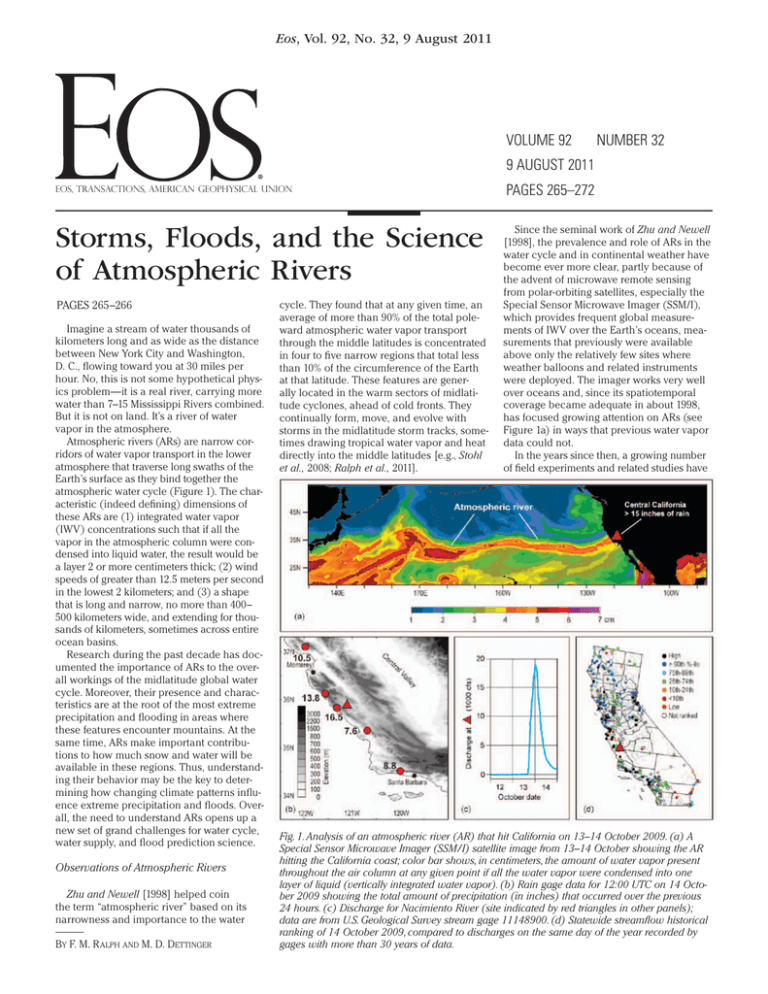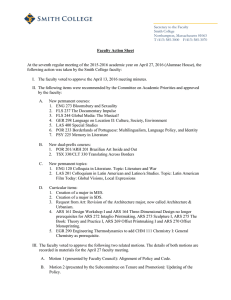Volume 92 number 32 9 AuGuST 2011 pAGeS 265–272
advertisement

Eos, Vol. 92, No. 32, 9 August 2011 Volume 92 number 32 9 AUGUST 2011 EOS, Transactions, American Geophysical Union Storms, Floods, and the Science of Atmospheric Rivers PAGES 265–266 Imagine a stream of water thousands of kilometers long and as wide as the distance between New York City and Washington, D. C., flowing toward you at 30 miles per hour. No, this is not some hypothetical physics problem—it is a real river, carrying more water than 7–15 Mississippi Rivers combined. But it is not on land. It’s a river of water vapor in the atmosphere. Atmospheric rivers (ARs) are narrow corridors of water vapor transport in the lower atmosphere that traverse long swaths of the Earth’s surface as they bind together the atmospheric water cycle (Figure 1). The characteristic (indeed defining) dimensions of these ARs are (1) integrated water vapor (IWV) concentrations such that if all the vapor in the atmospheric column were condensed into liquid water, the result would be a layer 2 or more centimeters thick; (2) wind speeds of greater than 12.5 meters per second in the lowest 2 kilometers; and (3) a shape that is long and narrow, no more than 400– 500 kilometers wide, and extending for thousands of kilometers, sometimes across entire ocean basins. Research during the past decade has documented the importance of ARs to the overall workings of the midlatitude global water cycle. Moreover, their presence and characteristics are at the root of the most extreme precipitation and flooding in areas where these features encounter mountains. At the same time, ARs make important contributions to how much snow and water will be available in these regions. Thus, understanding their behavior may be the key to determining how changing climate patterns influence extreme precipitation and floods. Overall, the need to understand ARs opens up a new set of grand challenges for water cycle, water supply, and flood prediction science. Observations of Atmospheric Rivers Zhu and Newell [1998] helped coin the term “atmospheric river” based on its narrow­ness and importance to the water By F. M. R alph and M. D. Dettinger cycle. They found that at any given time, an average of more than 90% of the total poleward atmospheric water vapor transport through the middle latitudes is concentrated in four to five narrow regions that total less than 10% of the circumference of the Earth at that latitude. These features are generally located in the warm sectors of midlatitude cyclones, ahead of cold fronts. They continually form, move, and evolve with storms in the midlatitude storm tracks, sometimes drawing tropical water vapor and heat directly into the middle latitudes [e.g., Stohl et al., 2008; Ralph et al., 2011]. pages 265–272 Since the seminal work of Zhu and Newell [1998], the prevalence and role of ARs in the water cycle and in continental weather have become ever more clear, partly because of the advent of microwave remote sensing from polar-­orbiting satellites, especially the Special Sensor Microwave Imager (SSM/I), which provides frequent global measurements of IWV over the Earth’s oceans, measurements that previously were available above only the relatively few sites where weather balloons and related instruments were deployed. The imager works very well over oceans and, since its spatiotemporal coverage became adequate in about 1998, has focused growing attention on ARs (see Figure 1a) in ways that previous water vapor data could not. In the years since then, a growing number of field experiments and related studies have Fig. 1. Analysis of an atmospheric river (AR) that hit California on 13–14 October 2009. (a) A Special Sensor Microwave Imager (SSM/I) satellite image from 13–14 October showing the AR hitting the California coast; color bar shows, in centimeters, the amount of water vapor present throughout the air column at any given point if all the water vapor were condensed into one layer of liquid (vertically integrated water vapor). (b) Rain gage data for 12:00 UTC on 14 October 2009 showing the total amount of precipitation (in inches) that occurred over the previous 24 hours. (c) Discharge for Nacimiento River (site indicated by red triangles in other panels); data are from U.S. Geological Survey stream gage 11148900. (d) Statewide streamflow historical ranking of 14 October 2009, compared to discharges on the same day of the year recorded by gages with more than 30 years of data. Eos, Vol. 92, No. 32, 9 August 2011 explored the physical characteristics and effects of ARs, focused mostly over the eastern Pacific Ocean and western North America (a bibliography of AR-­related research papers and many additional resources on ARs are available at http://w ww.esrl.noaa .gov/psd/­atmrivers/). Research aircraft observations in two ARs above the eastern North Pacific in the winters of 1998 and 2005 [Ralph et al., 2005, 2011] showed that they transported water vapor at about 13–26 cubic kilometers per day, a rate equivalent to 7.5– 15 times the average daily discharge of the Mississippi River into the Gulf of Mexico. A Closer Look at Rainfall From Atmospheric Rivers Because ARs transport so much water vapor, they represent a significant source of precipitation to coastal regions. For example, a recent numerical model study [Smith et al., 2010] estimated that roughly 20–40% of the water vapor transported ashore by an AR crossing over northern California was rained out there. This rainout happens because when ARs make landfall on the West Coast of North America (as well as on other continents [e.g., Stohl et al., 2008]), they are forced up and over coastal mountains, where they cool and condense large parts of their heavy burden of vapor [e.g., Neiman et al., 2008; Leung and Qian, 2009]. In a recent example, an AR event produced more than 410 millimeters (16.5 inches) of rainfall at one site in coastal California on 14–15 October 2009 (Figure 1). This particular AR had a very long fetch, spanning most of the North Pacific (Figure 1a), and upon making landfall deposited more than 200 millimeters of rain along a swath of coastal California several hundred kilometers wide (Figure 1b). Significant streamflow resulted, including a 5-­meter rise in water level on the Nacimiento River over 12 hours (Figure 1c), with the flows cresting at 525 cubic meters per second (18,600 cubic feet per second). Record-­high daily streamflows (for that date of year) were also observed at many other stations in central and northern California (Figure 1d). It should be noted that this peak flow of the Nacimiento River exceeded the annual peak flow in 28 of the past 40 years and did so in spite of the very dry conditions preceding this storm. This event exhibits key attributes found in other extreme ARs [e.g., Neiman et al., 2008; Ralph et al., 2011], including very large IWV values, indications of entrainment of tropical water vapor (from the western Pacific in this case, incorporating remnants of a western Pacific typhoon), and the fact that it stalled over parts of the West Coast in ways that amplified the storm’s impacts. Historically, AR storms have been the sources of many (and, in some areas, most) floods in the Pacific coast states. For example, all storms that resulted in declared flood conditions on the Russian River of central California from 1998 to 2005 arose from landfalling ARs [Ralph et al., 2006]; similar relations appear to exist between ARs and major flooding in most rivers from California to Washington State. In addition to their roles as producers of extreme storms and flood hazards, it is important to mention that ARs also are major contributors to western (especially California) water supplies [Dettinger et al., 2011; Guan et al., 2010]. Indeed, the half dozen or so ARs per year that make landfall in California have contributed an average of one third to one half of all the state’s precipitation, with a single typical AR storm yielding perhaps 2.5–5 cubic kilometers of precipitation, or roughly 10% of the annual average runoff of the entire Sacramento River basin. Studies of Atmospheric Rivers From the West Coast The dual roles of ARs as hazards and water resources in many coastal regions may become a more pressing issue under anthropogenic climate change, which may alter both hazardous and productive aspects of these storms [Dettinger, 2011]. For example, in view of the havoc that these storms wreak on the Pacific coast states, understanding and predicting them on time scales from days to decades, and at spatial scales from mountain ranges like the Sierra Nevadas and Cascades to individual river basins, present major challenges for West Coast meteorologists, climatologists, and hydrologists. Although research to address the roles of ARs elsewhere is mostly just beginning, AR research has been vigorous and productive on the West Coast for more than a decade. Over the past decade several studies led by the National Oceanic and Atmospheric Administration (NOAA) (see http://hmt.noaa.gov/) have explored the inner workings of ARs and the effects they produce, through intense field campaigns and the use of new meteorological and hydrometeorological sensors including radar and sounding assets, research aircraft, and other remote sensing tools as well as numerical models. As understanding of the scales and impacts of ARs has grown, scientific efforts have expanded to include other agencies on federal, state, and local levels, including the U.S. Geological Survey (USGS), the U.S. Army Corps of Engineers, NASA, California’s Department of Water Resources and the California Energy Commission, and local agencies around San Francisco Bay and in fire-­scarred areas of southern California. By now, a wide-­ranging collection of studies are currently under way on the West Coast to elucidate various aspects of AR phenomena and their impacts on the West Coast. One study is the Hydrometeorology Testbed-­West (HMT-­West), led by the Physical Sciences Division of NOAA’s Earth System Research Laboratory. HMT-­West includes long-­term geographically focused field research, as well as innovative monitoring and modeling to improve scientific understanding and short-­term prediction of extreme precipitation events and flooding associated with ARs. Efforts have been focused around the Russian and American river basins of central California. Another is the Enhanced Flood Response and Emergency Preparedness (EFREP) program led by California’s Department of Water Resources, NOAA, and Scripps Institution of Oceanography. EFREP seeks to foster development and deployment of statewide monitoring, modeling, and decision support programs that make key findings from HMT-­West operational, for better detection, monitoring, and prediction of ARs and their impacts. A key component is a “picket fence” of four evenly spaced coastal observatories to monitor ARs, statewide observational networks of soil moisture and IWV, and 10 snow-­level radars, all with associated decision support capabilities. The CalWater project, led by the California Energy Commission, NOAA, and Scripps, completed a major field campaign last winter that is providing data for research initiatives to address details of the interactions of ARs with topography, aerosols, and air pollution. Another goal is to critically assess ARs in climate models to quantify several key uncertainties in climate projections of precipitation for California [Dettinger, 2011]. A major project led by the USGS Multi-­ Hazards Demonstration Project, called ­ARkStorm, has developed a storm emergency scenario being used in hazards assessments and activities aimed at improving emergency preparedness and public awareness of the potential for catastrophic AR storms in California. Their scenario, based on the most recent AR science, rivals the largest storms and floods in California’s history and allows researchers to explore possible responses to historic levels of flooding, landslides, wind damage, water pollution, and attendant infrastructure and economic disruptions. Outside of California, in 2009 a major storm damaged an Army Corps of Engineers dam near Seattle that protects a heavily developed area from flooding. After that, dam operators could not use the full flood storage capacity of the reservoir (although repairs have now restored much of this capacity). To mitigate the risk of flood damages from 2009 to 2011, NOAA and the Corps applied concepts and tools for better monitoring of ARs that had been developed in California. AR-related observations were deployed to Washington State to provide actionable information on AR storms approaching the area above the dam. Finally, the Winter Storms and Pacific Atmospheric Rivers (WISPAR) project, jointly led by NOAA, NASA, and Northrop Grumman, performed field experiments in early 2011 using a high-­altitude, long-­endurance drone aircraft, the Global Hawk, to make offshore observations of several ARs over the Pacific Ocean. The field campaign included deploying a newly developed dropsonde system to document in detail the structure of water vapor transport in ARs. Eos, Vol. 92, No. 32, 9 August 2011 Details of these and other investigations are available at http://w ww.esrl.noaa.gov/ psd/­atmrivers/. A Scientific Challenge As is illustrated here, and as was highlighted in a special session on ARs at the 2010 AGU Fall Meeting (see http://hmt.noaa .gov/news/2011/012511.html), ARs have become a focus of research and development aimed at better physical understanding, monitoring, short-­term forecasts and warnings, and climate projections. Recognizing ARs is key to forecasting extreme precipitation and flooding in the Pacific coast states and is now included in forecaster training by NOAA and other agencies. Because of the vast amounts of water that they transport and deliver, ARs are probably just as important in many other regions of the globe where they have been less studied. For example, recent flood catastrophes in Nashville, Tenn. (May 2010), and North and South Carolina (October 2010) were associated with ARs making landfall from over the Gulf of Mexico and Atlantic. The central role of ARs in water cycle dynamics outside the tropics, increasing pressure on limited water resources, and changing exposures to flood risks due to development and climate changes all demand improved scientific understanding and forecasts of ARs. Providing those improvements makes ARs a grand challenge for water cycle science, with important implications for flooding and water supply. References Dettinger, M. (2011), Climate change, atmospheric rivers, and floods in California—A multimodel analysis of storm frequency and magnitude changes, J. Am. Water Resour. Assoc., 47(3), 514–523, doi:10.1111/j.1752-1688.2011.00546.x. Dettinger, M. D., F. M. Ralph, T. Das, P. J. Neiman, and D. R. Cayan (2011), Atmospheric rivers, floods and the water resources of California, Water, 3(2), 445–478, doi:10.3390/w3020445. Guan, B., N. P. Molotch, D. E. Waliser, E. J. Fetzer, and P. J. Neiman (2010), Extreme snowfall events linked to atmospheric rivers and surface air temperature via satellite measurements, Geophys. Res. Lett., 37, L20401, doi:10.1029/ 2010GL044696. Leung, L. R., and Y. Qian (2009), Atmospheric rivers induced heavy precipitation and flooding in the western U.S. simulated by the WRF regional climate model, Geophys. Res. Lett., 36, L03820, doi:10.1029/2008GL036445. Neiman, P. J., F. M. Ralph, G. A. Wick, J. Lundquist, and M. D. Dettinger (2008), Meteorological characteristics and overland precipitation impacts of atmospheric rivers affecting the West Coast of North America based on eight years of SSM/I ­satellite observations, J. Hydrometeorol., 9(1), 22–47, doi:10.1175/2007JHM855.1. Ralph, F. M., P. J. Neiman, and R. Rotunno (2005), Dropsonde observations in low-level jets over the northeastern Pacific Ocean from CALJET-1998 and PACJET-2001: Mean vertical-­profile and atmospheric-­r iver characteristics, Mon. Weather Rev., 133(4), 889–910, doi:10.1175/MWR2896.1. New Education and Outreach Opportunities for Scientists PAGES 266–267 A scientist works late to finish up yet another proposal for research funding. Time is short—the proposal is due in only a week. The research description is well in hand, compelling and at the forefront of the field. But the scientist is less confident of what to propose for a “broader impacts” component that will actually be meaningful. What does it mean to have a broader impact? What can be proposed that will make a difference but will not divert too much time from conducting research, searching for funding, or writing papers? For many scientists, particularly those who rely on soft money for research funding, the above scenario is a familiar story. These days, research solicitations from funding agencies consistently require that in addition to proposing innovative and cutting-edge research, scientists must also include elements in their proposals that provide meaningful broader impacts to their research programs—in essence, they must show how their research will benefit society and spread knowledge. To help scientists, research programs, and organizations tackle this part of their grant proposals, the National Earth Science Teachers Association (NESTA; http://w ww .­nestanet.org) is offering a number of opportunities that can help bring new research to teachers, students, and the public. Through these opportunities, new and dynamic science can reach a broad population without forcing researchers to build outreach programs from scratch. Maximizing Outreach Efforts Through NESTA Grant requirements vary in the types of activities that qualify for outreach elements, and they can range from providing undergraduate research opportunities to working with K–12 teachers or reaching out to the community through informal educational organizations or events. The challenge for many scientists seeking to undertake K–12 or public outreach activities is finding a way to provide meaningful broader impacts that actually reach significant numbers of people. While developing a new Web site to share science can be creative and enjoyable, experience proves that it is very difficult to draw attention to Web-based resources in the vast maze that is the Internet today unless the resources are linked to or made available on Ralph, F. M., P. J. Neiman, G. A. Wick, S. I. Gutman, M. D. Dettinger, D. R. Cayan, and A. B. White (2006), Flooding on California’s Russian River: Role of atmospheric rivers, Geophys. Res. Lett., 33, L13801, doi:10.1029/2006GL026689. Ralph, F. M., P. J. Neiman, G. N. Kiladis, K. Weickmann, and D. W. Reynolds (2011), A multi­ scale observational case study of a Pacific atmospheric river exhibiting tropical-­extratropical connections and a mesoscale frontal wave, Mon. Weather Rev., 139(4), 1169–1189, doi:10.1175/2 010MWR3596.1. Smith, B. L., S. E. Yuter, P. J. Neiman, and D. E. Kingsmill (2010), Water vapor fluxes and orographic precipitation over northern California associated with a land-­falling atmospheric river, Mon. Weather Rev., 138(1), 74–100, doi:10.1175/2009MWR2939.1. Stohl, A., C. Forster, and H. Sodemann (2008), Remotes sources of water vapor forming precipitation on the Norwegian west coast at 60°N: A tale of hurricanes and an atmospheric river, J. Geophys. Res., 113, D05102, doi:10.1029/ 2007JD009006. Zhu, Y., and R. E. Newell (1998), A proposed algorithm for moisture fluxes from atmospheric rivers, Mon. Weather Rev., 126(3), 725–735, doi:10.1175/1520- ­0 493(1998)126<0725:APAFMF >2.0.CO;2. Author Information F. M. Ralph, Physical Sciences Division, Earth System Research Laboratory, NOAA, Boulder, Colo.; E-­mail: marty.ralph@noaa.gov; and M. D. Dettinger, USGS and Scripps Institution of Oceanography, La Jolla, Calif. a Web site already heavily used by the audience the scientist is trying to reach. Likewise, while visiting a classroom in a local primary or secondary school can be very rewarding for all involved, many scientists would like to have opportunities to have an effect on larger numbers of teachers and students. Scientists naturally have limited amounts of time they can devote to outreach elements while also pursuing their demanding research and other professional responsibilities. Reaching a large audience, though, requires substantial effort, and the scientist does not want to waste his or her time. Considering the small amount of funding from grants that scientists can typically apply to these activities, coupled with the critical importance of science to society, it is imperative that scientists find effective and efficient approaches for public outreach through research projects that magnify the effects of their efforts. Through NESTA, scientists do not have to look far to maximize their outreach efforts. As a 501(c)(3) tax-exempt professional society, founded in 1983 with a mission to facilitate and advance excellence in Earth and space science education, NESTA directly serves the K–12 Earth and space science educator community nationally as well as through affiliate organizations working at the state level. NESTA recently became the host of Windows to the Universe (W2U; http://w ww .­windows2universe.org), an Earth and space
![Rivers in the sky!!! (Atmospheric Rivers [ARs]) SIO 209: Weather Discussion](http://s2.studylib.net/store/data/014050054_1-a9db3e03dccdc1b5d7aa99f4f63e811f-300x300.png)


